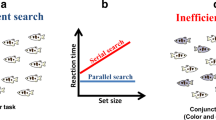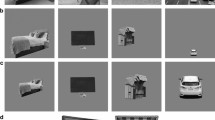Abstract
The confusion effect describes the observed decrease in the likelihood that a predator will successfully catch any prey when attacking larger groups of moving prey. We introduce readers to the work of cognitive psychologists interested in human visual attention who have been studying their own version of the confusion effect for many years, developing methods and concepts that may be of fundamental utility to behavioral ecologists. In psychology, ‘basic features’ are characteristics unique to a target object in the visual field that no distracter objects share. Images containing targets with basic features are often less likely to induce the confusion effect in human subjects. Target objects with conjunctions of features, on the other hand, have no individual characteristics unique from distracters, but unique characteristics in combination. Such targets more often induce the confusion effect in humans. We propose the ‘basic feature’ (vs. conjunctions of features) as a new organizing concept for studies on the occurrence of the confusion effect in nature, potentially allowing predictions about which types of prey groups are likely to induce the confusion effect in predators.

Similar content being viewed by others
References
Jeschke JM, Tollrian R (2005) Effects of predator confusion on functional responses. OIKOS 547:547–555
Jeschke JM, Tollrian R (2007) Prey swarming: which predators become confused and why? Anim Behav 74:387–393
Krause J, Ruxton GD (2002) Living in groups. Oxford University Press
Krebs JR, Davies NB (1993) An introduction to behavioural ecology, 3rd edn. Blackwell, Oxford
Ruxton GD, Jackson AL, Tosh CR (2007) Confusion of predators does not rely on specialist coordinated behaviour. Behav Ecol 18:590–596
Treisman A, Gelade G (1980) A feature integration theory of attention. Cognitive Psychol 12:97–136
Wolfe JM (1998) Visual search. In: Pashler H (ed) Attention. Psychology, Hove, East Sussex, pp 13–73
Wolfe JM (2005) Guidance of visual search by preattentive information. In: Itti L, Rees G, Tsotsos JK (eds) Neurobiology of attention. Elsevier, London, pp 101–104
Wolfe JM, Cave KR, Franzel SL (1989) Guided search: an alternative to the feature integration model for visual search. J Exp Psychol Human 15:419–433
Acknowledgment
This work was funded by the UK Natural Environment Research Council (NERC) grant NE/D010772/1.
Author information
Authors and Affiliations
Corresponding author
Additional information
Communicated by P. A. Bednekoff
Rights and permissions
About this article
Cite this article
Tosh, C.R., Krause, J. & Ruxton, G.D. Basic features, conjunctive searches, and the confusion effect in predator–prey interactions. Behav Ecol Sociobiol 63, 473–475 (2009). https://doi.org/10.1007/s00265-008-0667-4
Received:
Revised:
Accepted:
Published:
Issue Date:
DOI: https://doi.org/10.1007/s00265-008-0667-4




